An interview with Elena Bykova, founder of the Saiga Conservation Alliance
In a decline on par with that suffered by the American bison in the Nineteenth Century, in the 1990s the saiga antelope of the Central Asian steppe plummeted from over one million individuals to 50,000, dropping a staggering 95 percent in a decade and a half. Since then new legislation and conservation measure have helped the species stabilize in some areas but in others the decline continues.
Working for six years with the Saiga Conservation Alliance, Founding Member and Executive Secretary Elena Bykova has helped bring the species back from the very brink of extinction.
“I remember the time when the saiga was hunted and traded, and we all believed that it was one of most numerous game species in Eurasia,” Bykova, a native of Uzbekistan, says, but then she and other biologists began to notice that something had gone very wrong for the species. “We visited saiga habitat in Uzbekistan under this project and were shocked: so much of the Ustyurt plateau, where saigas once lived in Uzbekistan, looked like a dinosaur cemetery. It was covered by saiga’s skulls with succise horns, skeletons, and bones – terrible vision!”
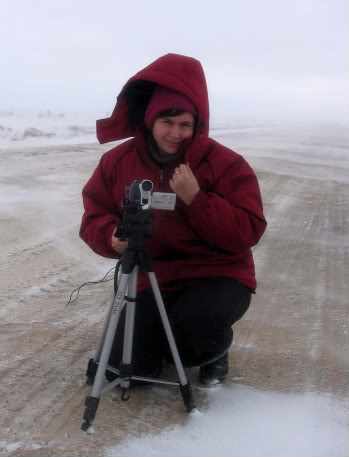 Working with saiga’s sometimes means surviving severe winters. Elena Bykova in Ustyurt. Photo by: Alexander Esipov. |
It was after witnessing the toll poaching had taken on the species that Bykova says “we all understood very clearly that it’s not enough for us to be only scientists – we must do something toward saving the saiga as conservationists.”
While “poaching, both for meat and for its horn used in traditional Chinese medicine, has been the primary factor driving the decline of this unique nomadic mammal,” Bykova explains that political and economic upheaval are behind the poaching epidemic.
“The saiga’s fate has been closely tied to economic changes in the former Soviet Union, whose breakup in 1991 was accompanied by the collapse of rural economies causing widespread unemployment and poverty.”
It is very clear that Bykova is fascinated by the strange saiga and her enthusiasm is contgious: with its weird trunk-like nose and tall horns the animal looks like it arrived from a fantasy novel, but it is lone survivor of a long ago era: “Unbelievably, this ice age relic lived in the same time and in the same habitat as the mammoths and wooly rhinos 60,000-70,000 years ago! They survived thanks to great adaptation potential and their unique ability to move huge distances,” Bykova says.
The decline of the saiga throughout Central Asia has affected the entire steppe ecosystem.
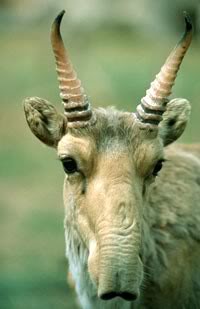 “And of course, the most remembered feature of the saiga is its strange nose, which looks like a short trunk. The saiga’s nose isn’t decoration. It’s a big filter to clean dusty air in summer and warm it in winter,” Bykova says, explaining the saiga’s most unusual appearance. |
“The saiga is a keystone species of the steppe. It inhabits dry lands and saline lands, where it feeds on food plants (salsola and wormwood) unsuitable for others ungulates and domestic cattle. These plants are very important for the steppe and the saiga considerably influence the character of natural vegetation of this ecosystem.”
While Bykova adds that the situation is complicated and scientists are unsure just how much impact the saiga decline has had, she explains that some species have been particularly impacted by the decline of the saiga, including “wolves and birds of prey that were their main predators, and small rodents and ground-nesting birds that require grazed vegetation.”
Despite such a precipitous decline, Bykova says that the saiga has not received the attention from the media and public it deserves.
“People outside Central Asia know very little about the saiga antelope. It’s strange that they know a lot about extinct mammoths, but no one hears anything about its neighbor – the living relic, saiga.”
In order for the species not to follow the mammoth into oblivion, Bykova says more awareness, political pressure, and funding are needed.
In a September interview with mongabay.com, Bykova spoke about the saiga’s natural history, its precipitous decline, and the work to bring it back from the edge of extinction.
Bykova will be presenting at the upcoming Wildlife Conservation Network Expo in San Francisco on October 3rd.
INTERVIEW WITH ELENA BYKOVA
Mongabay: What is your background? How did you become interested in the saiga antelope?
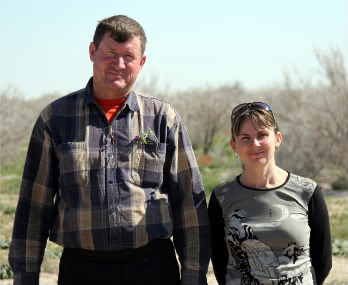 Elena Bykova and her husband Alexander Esipov, also a member of the SCA Steering Committee. Photo by: Stacey Iverson. |
Elena Bykova: I work in Uzbekistan at the Institute of Zoology on national and international projects on endangered species status assessments, including INTAS Red list project on endangered species of Central Asia. One day when we conducted the saiga status assessment I became very worried about the dramatic decline of the antelope. I remember the time when the saiga was hunted and traded, and we all believed that it was one of most numerous game species in Eurasia. My friend and colleague E.J.Milner-Gulland, Professor in Conservation Science from Imperial College London, UK invited me and my husband Alexander to take part in an international project on investigating saiga reproductive biology. We visited saiga habitat in Uzbekistan under this project and were shocked: so much of the Ustyurt plateau, where saigas once lived in Uzbekistan looked like a cemetery of dinosaurs. It was covered by saiga’s skulls with succise horns, its skeletons and bones – terrible vision! After finishing this project when all conclusions were made, we all understood very clearly that it’s not enough for us to be only scientists – we must do something toward saving the saiga as conservationists. It’s why we created the unit under the roof of the Saiga Conservation Alliance. During the last 6 years I have worked for saiga conservation in my country and internationally, and I am very happy to spend my efforts on this amazing species. I really believe that we can save it. I would be happy if new enthusiastic people joined us for this noble aim
Mongabay: What makes the saiga unique?
Elena Bykova: The saiga doesn’t have relatives. It is a unique species with its own genus, Saiga. The saiga is one of the ancient species in the world. Unbelievably, this ice age relic lived in the same time and in the same habitat as the mammoths and wooly rhinos 60,000-70,000 years ago! They survived thanks to great adaptation potential and their unique ability to move huge distances. Saigas are real nomads. They migrate round the year. As perpetually mobile, they move without stopping to look for the food, water, and suitable places. Saigas are also excellent runners. And of course, the most remembered feature of the saiga is its strange nose, which looks like a short trunk. The saiga’s nose isn’t decoration. It’s a big filter to clean dusty air in summer and warm it in winter.
Mongabay: In a single decade the population of saiga antelopes has dropped by 96 percent. What happened?
 Recording saiga tracks. Photo by: Alexander Esipov. |
Elena Bykova: The saiga antelope is listed as Critically Endangered on the IUCN Red List, and in the Red Data Book of Uzbekistan as the species with the fastest decline ever recorded for a mammal species. Poaching, both for meat and for its horn used in traditional Chinese medicine, has been the primary factor driving the decline of this unique nomadic mammal. The saiga’s fate has been closely tied to economic changes in the former Soviet Union, whose breakup in 1991 was accompanied by the collapse of rural economies causing widespread unemployment and poverty. Poaching is facilitated by poor management of conservation agencies due to limited resources and often the indifference of authorities. The Chinese market, which opened up for post Soviet countries after the collapse of the FSU turned out to be extremely lucrative for sales of natural ram materials including saiga’s horns. Since ancient times saiga horns have been used in traditional Chinese Medicine for treatment of wide range of ailments (cold, high blood pressure, detoxication, pulmonary diseases, etc.). Description of the use of saiga antelope’s horns can be found in Shengnong Bencao, a medical tractate published 2,000 years ago. As a result of opened boundaries and emerged demand, rates of saiga antelope poaching increased multiple-fold, putting it on the brink of extinction.
Mongabay: How has the dramatic decline of the saiga affected the rest of the steppe ecosystem?
Elena Bykova: The saiga is a keystone species of the steppe. It inhabits dry lands and saline lands, where it feeds on food plants (salsola and wormwood) unsuitable for others ungulates and domestic cattle. These plants are very important for the steppe and the saiga considerably influence the character of natural vegetation of this ecosystem. It’s hard to know what effect the loss of the saiga population has had on the steppe ecosystem, because at the same time there was a similarly dramatic collapse in the numbers of livestock using the steppe. This was also because of the collapse in the rural economy after the break-up of the Soviet Union, before which there were millions of sheep and goats sharing the rangelands with saigas. There are also other big changes such as climate change and the drying of the Aral Sea that complicate the story. Species that may have been very much affected by the loss of saigas and other small ungulates include wolves and birds of prey that were their main predators, and small rodents and ground-nesting birds that require grazed vegetation.
Mongabay: What are the current threats to the saiga antelope?
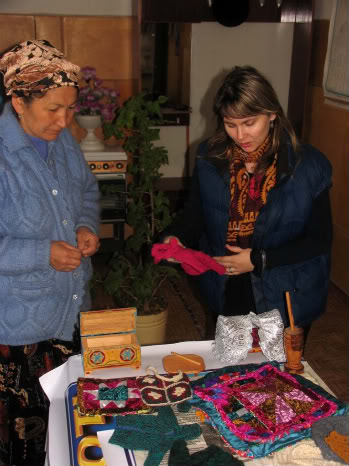 Production of school handicrafts from a club in Jaslyk. Supported by SCA. Photo by: Alexander Esipov. |
Elena Bykova: Factors that limit saiga numbers include weather conditions—during a severe winter up to 50% of the animals can die; wolves which kill sick adults or those weakened by the rut; and foxes and golden eagles which mostly hunt for new babies. And, of course, disease can lead to population declines. But all of these factors have a natural character and saigas, during their long history, have adapted to them. Currently the main threat for saigas is poaching. Analysis of the current situation of saiga exploitation in Uzbekistan, as well other range states as Mongolia, Russia and Kazakhstan, showed that it was predominantly local people who are engaged in poaching. High demand for the saiga’s horns in conditions of general economic depression and increasing unemployment rate, and an almost complete lack of control over biodiversity use in the region triggered the incentive for poaching. Our assessments show that the income derived from poaching equals to nearly 10% of the total household revenue in the communities. Poaching is still at high levels in many parts of the saiga’s range.
Mongabay: How has the male saiga’s horn contributed to the species’ decline?
Elena Bykova: Because only saiga males bear the precious horn, poachers have disproportionately slaughtered males. This caused a reproductive collapse, accelerating the rate of population decline to the brink of extinction. However, saiga males can mate with many females, so the population can breed normally even when there are only 5% males in the population. Nowadays male numbers are not so dangerously low, and the populations appear to be breeding OK.
Mongabay: What is Saiga Conservation Alliance doing to save the species?
Elena Bykova: The Saiga Conservation Alliance (SCA) is a network of researchers and conservationists collaborating to study and conserve the saiga. SCA is multinational team that acts in each saiga range state and internationally. We work to stop both saiga poaching and saiga meat consumption, as well as to create a new understanding and appreciation of nature conservation among the local community and local governments. We believe that communication between all parties is vital, and one of the ways we do this is by publishing Saiga News twice a year in 6 languages, which tells all saiga enthusiasts about the latest developments for its conservation.
Within Uzbekistan, the SCA has been carrying out a range of activities for saiga conservation, including monitoring; educational work among local communities and all interested parties, such as industrial companies developing natural resources in saiga habitat; promotion of traditional handicrafts; and support for government in setting up an effective saiga conservation, including territorial protection.
We also have a small grants competition that gives start-up funding to grassroots initiatives to conserve the saiga throughout its range, enabling people who wouldn’t otherwise have access to international funding to develop their conservation ideas.
Mongabay: One of your projects involved providing local poor families with a milk cow. How did this help the saiga?
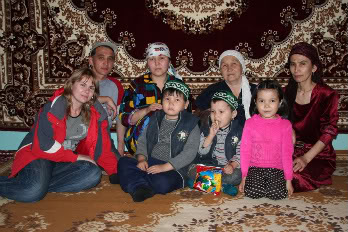 Elena with local family and saiga friends in the Ustyurt plateau, the village of Karakalpakiya. Photo by: Alexander Esipov. |
Elena Bykova: In 2003 we carried out some research in Kalmykia, Russia, asking local people about their lives, what people knew and felt about saigas, why people poached, and how we could help local families in a time of desperate poverty. They told us that they needed help setting up livestock enterprises, and if a poor family had a cow that would be enough to support them through selling and eating the dairy products and the calves. We also found out that the main reason why people poach is poverty and unemployment. So with the help of a grant from the UK government (DEFRA and the British Council) we bought four cows and a bull. We gave two of them to local families in two villages where poaching was a problem, chosen on the basis of need. The other two and the bull stayed as a core herd at the saiga breeding centre, where their milk was given to local schools and orphanages. We gave the families help with veterinary care, built them a stall for the cow and bought them fodder for the first winter. The agreement was that the first female calf was to be returned to the project to be passed on to the next family.
The project has been very successful and now we have 12 families with cows. It caused a lot of good publicity, firstly because it was a new idea for Kalmykia, and secondly because people realized that we did care about them and their lives, and not just about saigas. It captured their imagination, and put the saiga breeding centre on the map. There was no explicit link to stopping poaching, but the good will it generated, and the understanding that a village could only be part of the scheme if it stopped supporting poaching, has helped saigas a lot, we think.
Mongabay: How does education, especially of local children, help the saiga?
Elena Bykova: Talking about education we should take into account that it’s a long term strategy for nature conservation, which inevitably yield results that are difficult to measure quantitatively and are often not immediately visible. Working with children, we provide a new vision based on understanding the relationship between human well-being and that of wildlife to make it less likely that today’s schoolboys become tomorrow’s poachers. We have found that providing conservation education to children is an effective way to present new ideas, through them, to adults. Children involved in our education programs have frequently shared their new knowledge with parents, such that adults have deepened their environmental understanding and developed a more conservation-based vision.
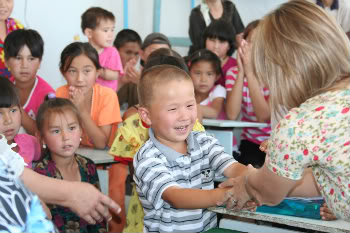 Awarding children in Kubla-Ustyurt. Photo by: Alexander Esipov. |
One specific example of the impact of our work is of a young man who approached me whilst I was visiting a village last year. He told me that since we had visited his son’s school and taught his class about saiga, his son has refused to eat saiga meat and has told his family that they mustn’t buy it anymore. So his whole family has stopped buying and eating saiga meat. Even if we have to change attitudes one by one, I am sure that our work is having a positive impact on the people living within the saiga range.
Mongabay: Russia has just signed the ‘Memorandum of Understanding on the Conservation, Restoration and Sustainable Use of the Saiga Antelope’. What does this mean for the conservation of this Critically Endangered species?
Elena Bykova: Saiga is a transboundary migrant inhabiting 5 countries. Even excellent species protection in one or a few countries can’t guarantee real species protection. So, for effective conservation it’s necessary to unite the efforts of all range states.
When the MoU first came into force in 2006, the SCA wrote a Medium Term Work Programme for saigas under the Convention on Migratory Species, which all the range states agreed to support. The programme includes a list of prioritized actions for each population and each issue affecting saigas. We were also commissioned by the CMS to monitor progress towards fulfilling this programme, and the fact that we are doing this (you can see our reports on our website) means that there is transparency and we can all see where more action is needed.
This is why Russia signing the MoU (the last saiga range state country to sign the MoU!) is critically important and opens new horizons in conservation and management of saiga populations. Now that all the range states are signatories to the MoU, it can provide really effective conservation actions within all saiga range and coordination of activities.
Mongabay: The saiga has gone extinct in China. Have there been any discussions of reintroducing the saiga to parts of China?
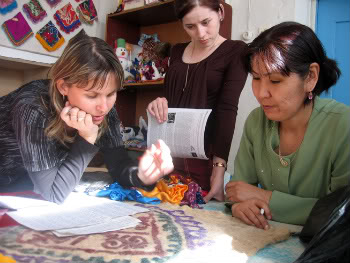 Saiga competition organizing in local school. Photo by: Alexander Esipov. |
Elena Bykova: China is the main market for saiga horns, so it is really important that they are committed to working together with the range states to stop the illegal trade in saiga horns. Some of this work has started, including illegal trade assessment, improvement of legislation on illegal trade of saiga and saiga products, as well as a public awareness programme carried out by our colleagues at WCS-China. It’s good but not enough. We should aim for more active engagement by China in saiga conservation activities.
China also has a saiga captive breeding programme in one breeding centre and is keen to expand this and also to reintroduce saigas into their former range. We think that the problem of illegal trade should be solved first before spending lots of time and money on captive breeding or reintroduction of animals that may just end up being poached.
Mongabay: How optimistic are you about the future of the saiga?
Elena Bykova: I’m very optimistic about future of saiga. My confidence in it based on four foundations: 1.biological peculiarities of saiga; 2. former conservation experience; 3. current tendency of population stabilization; 4. international will.
1. Biological peculiarities of saiga: the saiga has huge biological potential. It is an ungulate species with quite a short life cycle – 6-7 years for males, 12-13 years for females. Saigas become mature at a rather young age – females around 1-1.5 years old, males – 2-2.5 year. Saigas have very high fecundity. Females commonly birth twins, rare singleton and very rare triplets. Already in a few days calves can follow their mother. So, theoretically saigas can restore their numbers during short period 5-10 years. We just need to create favourable conditions for their rehabilitation.
2. Former conservation experience: also my optimism is based on the experience of saiga rehabilitation in former Soviet Union in 1920-1950s when due to strong conservation measures saiga survived extinction. If in the 1920s the word population of the saiga was assessed as 1000 individuals, in the 1980s its number reached commercial size – more than 1 million animals. So saigas can recover very quickly if we put effective conservation measures into place.
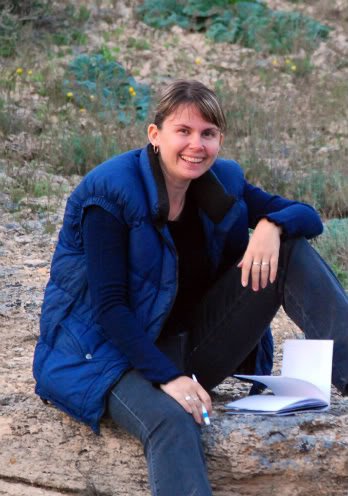 Elena in saiga area, Beleuly fortress in Uzbekistan. Photo by: Stacey Iverson. |
3. The current tendency of population stabilization: counts of saiga numbers in Central and Western Kazakhstan, Kalmykia, Russia and Mongolia give us optimistic prognoses on stabilization of some saiga populations. The Ustiurt population (which includes Uzbekistan’s saigas) is not stabilising though due to continued heavy poaching, and it is worrying that there still seems to be poaching ongoing in other areas as well, particularly in Russia.
4. International will: there is a real will to make saiga conservation succeed; our network is full of enthusiastic and optimistic people who are completely committed to saiga recovery. This is the first step to making a difference.
Mongabay: What can people do to help the saiga?
Elena Bykova: People outside Central Asia know very little about the saiga antelope. It’s strange that they know a lot about the extinct mammoth, but no one hears anything about its neighbor – the alive relic saiga. I see a very important role for mass media and the general public to improve understanding of the saiga. Without their help it may go extinct like the mammoth.
We need your help to attract the attention of decision makers to the saiga problem (for instance, we worry very much about the slow process of signing bilateral agreements on saiga conservation between range states such as Uzbekistan, Kazakhstan and Turkmenistan due to political gaps) and fundraising for conservation actions. Also we need your help to express concern over the saiga’s fate and the mental connection with people who live and whose lifestyle, economic and cultural, very closely correlate with the saiga’s.
And of course, any financial support of saiga programmes, even very small amounts, are very valuable. They allow us, together with you, to make next step forward for saving the saiga. If you look at our website www.saiga-conservation.com, you will see how to donate, and information about what we’re doing in each of the saiga’s range states to support saiga conservation.
Saiga Conservation Alliance
Bykova will be presenting at the upcoming Wildlife Conservation Network Expo in San Francisco on October 3rd
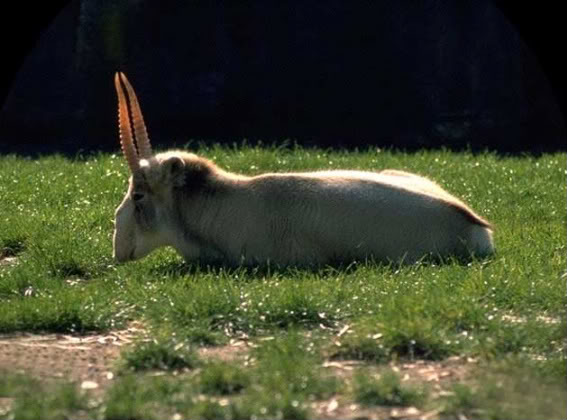
The saiga antelope.
Related articles
Migrations of large mammals in serious declines, six have vanished entirely
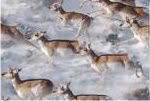
(06/03/2009) Watch any nature documentary and it’s sure to include pulse-pounding footage of large herbivores migrating across African plains, Asian steppe, or the Arctic tundra. The images have become iconic: wildebeest forging a crocodile-inhabited river, caribou breaking through snow fields, Saiga running over tall grass. Despite such images of plenty, migrations are declining across the world, and in six cases have disappeared entirely.
The end of migrations: wildlife’s greatest spectacle is critically endangered
(07/28/2008) If we could turn back the clock about 200 years, one could watch as millions of whales swam along their migration routes. Around 150 years ago, one could witness bison filling the vast America prairie or a billion passenger pigeons blotting out the sky for days. Only a few decades back and a million saiga antelope could be seen crossing the plains of Asia.
Population of bizarre Mongolian antelope plunges 95% in 15 years
(10/19/2006) A group of scientists led by the New York-based Wildlife conservation Society (WCS) working in Mongolia’s windswept Gobi Desert recently fitted high-tech GPS (Global Positioning System) collars on eight saiga antelope in an effort to help protect one of Asia’s most bizarre-looking — and endangered — large mammals.